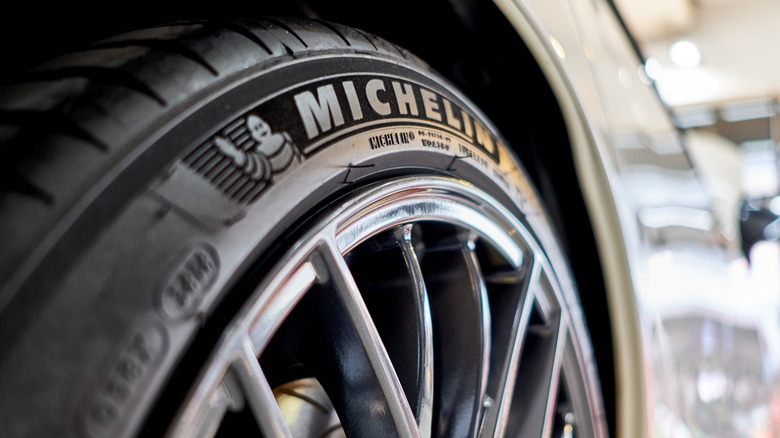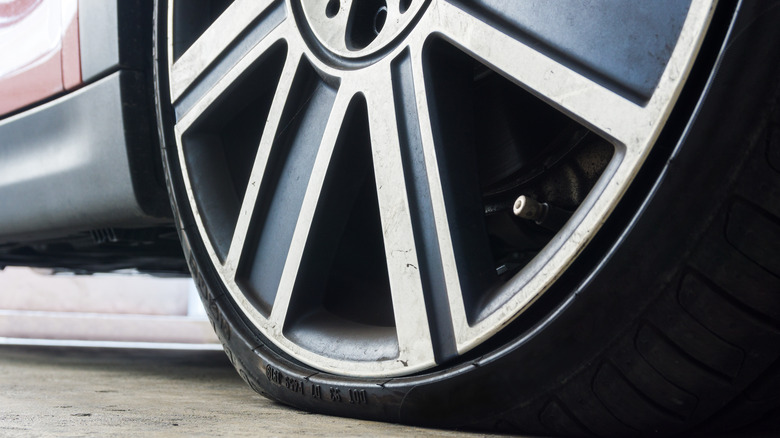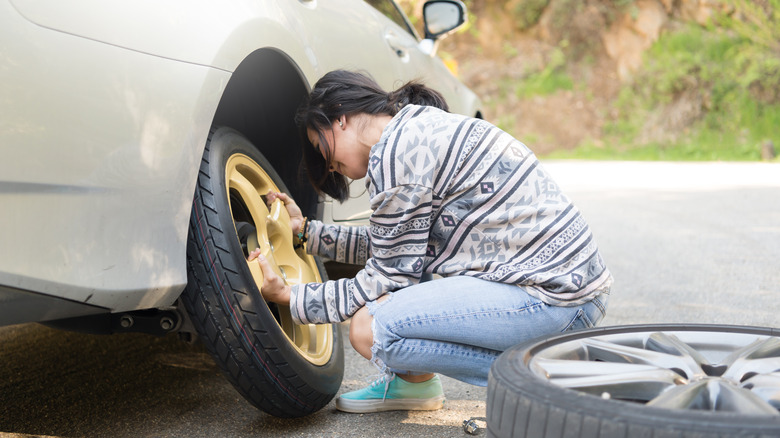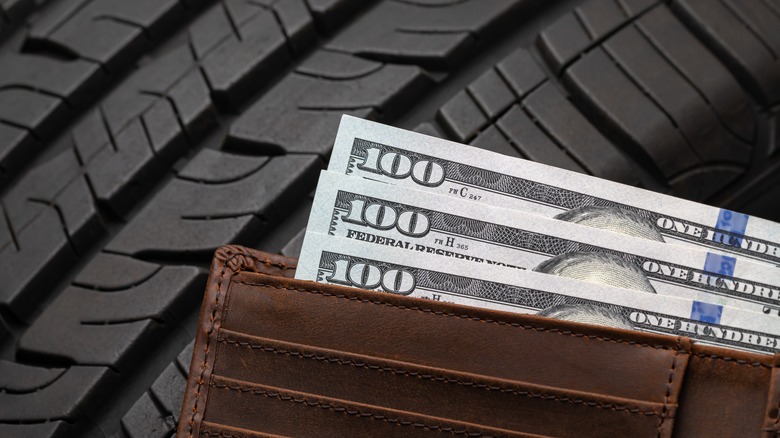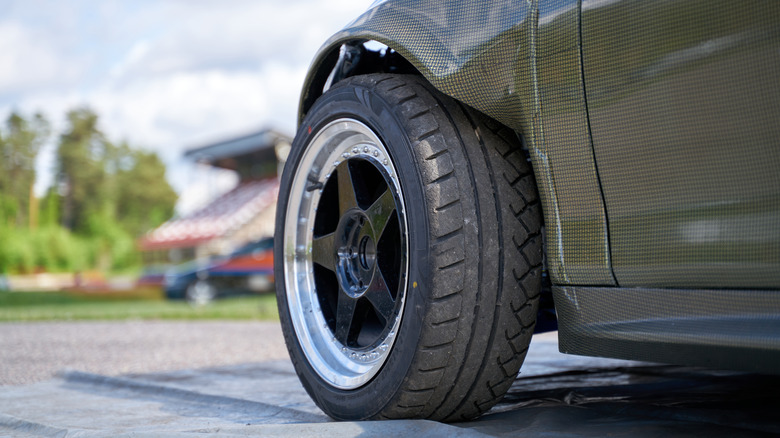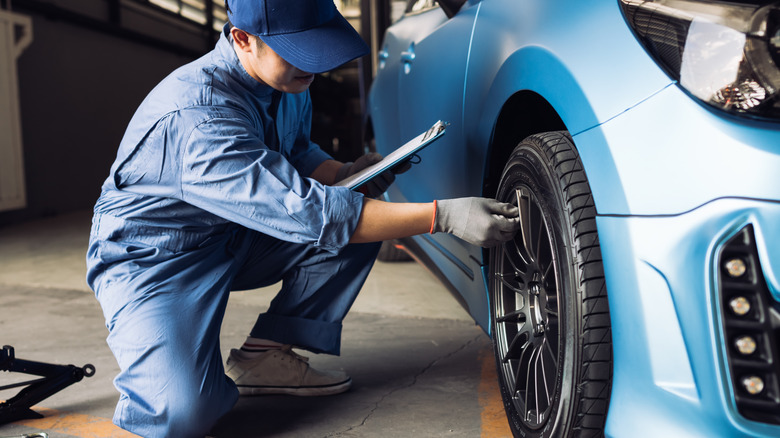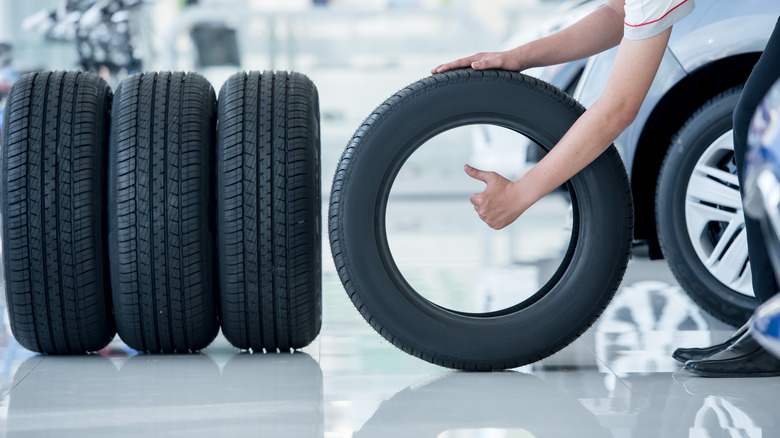What Are Run Flat Tires And How Do They Work?
Run-flat tires are very different than conventional tires. They may look similar from the outside, but there's a world of innovation inside. Unlike standard rubber, run-flat tires or zero-pressure tires have reinforced sidewalls to support the vehicle's weight even after a complete loss of air pressure (via Bridgestone). Of course, what this means is you can continue driving at a predetermined speed and distance after a puncture, allowing you to reach a workshop or service center and change the tire. Bridgestone points out that its run-flats, for example, can drive up to 50 miles at a maximum speed of 50 miles per hour.
This all sounds fine and dandy, but there are tradeoffs to consider with run-flat tires. Before spending your hard-earned cash on a brand-new set of run-flats, here is everything you need to know about run-flat tires in general, including their pros and cons and what to look out for.
How do run-flat tires work?
There are two general types of run-flat tires: Self-supporting and self-sealing (via in2tires). The former utilizes a stiffer and reinforced sidewall construction to support the vehicle after losing air pressure. Meanwhile, the latter features a thin layer of sealant that helps maintain air pressure after a puncture, in2tires notes, pointing out that self-sealing run-flat tires still need air to operate correctly, while self-supporting run-flats can keep you going even after losing all air pressure.
The Drive explains that the most common run-flat tire you can buy is the self-supporting tire, although manufacturers like Pirelli and Continental are now offering self-sealing run-flat tires. You can identify a run-flat tire by visually inspecting the sidewall. Depending on the brand, run-flat tires will have RFT (Run-Flat Tire), SSR (Self-Supporting Run-Flat), EMT (Extended Mobility Tire), or ZP (Zero Pressure) markings, according to Toee Tire.
Run-flat tires are not compatible with any vehicle. Only vehicles that came with run-flats from the factory can use run-flat tires. Besides having a standard TPMS, new cars with standard run-flats have particular changes to the suspension and chassis to accommodate those special tires — otherwise, Family Handyman notes, the tires may unexpectedly separate from the wheel bead. If your vehicle originally came with run-flat tires, it is possible to replace them and mount conventional tires instead, as Firestone explains. Remember that OEM run-flat vehicles do not have tire-changing tools and a spare tire in the trunk, so keep this in mind before making the switch.
What are the pros?
There is one major pro to a run-flat tire. As the name suggests, you can continue driving on it even after a puncture or other sudden loss of pressure. The durable construction and reinforced sidewall typically mean you can continue to drive at up to 50 miles per hour, and cover around 50 miles of distance before the flattened tire wears out. This is a huge advantage over a regular tire, which you shouldn't really drive on at all.
Run-flat tires mean that you could theoretically dispose of the spare in the trunk, along with the car jack and socket wrench you'd need to install it. It also means that you'll no longer have to spend time at the roadside putting on a spare, nor will you have to call for emergency assistance if you're unlucky enough to have something like a double blowout. To put it in perspective, 50 miles should be enough to get you to a tire shop. It's all most compact spare wheels, or "donuts" are generally rated for. Some brands of run-flat tires can go even further.
While a full-sized spare can go for the life of the tire, it isn't necessarily a better option than a run-flat either. If the tire tread on your full-sized spare doesn't match the tread on your other drive wheel you could have issues. You're also out a spare tire until you get to the tire shop anyway, so you should really be heading there as a priority.
What are the cons?
While the ability to go without a spare is a huge benefit, there are some major downsides to run-flat tires. First of all, due to their reinforced construction, they're significantly heavier than a standard tire — which means your ride comfort, handling, and braking may be negatively affected. There's a reason tires aren't just a solid strip of rubber, and run-flats are a step toward that bad idea.
Then there are the costs to consider. Run Flat tires typically cost around 25% more than standard wheels, and that cost increases when something eventually does go wrong. If you run over a nail and get to a tire shop in time, standard tires can often be cheaply repaired. Run flats can't be repaired, and you'll need to shell out for a new one. Then there is availability to consider. Run flat tires that fit your car can be difficult to find, and if you get a puncture while traveling, you may have to have a standard tire fitted and then buy yet another run flat when you get back.
Then there's the fact many cars can't even use them. Because of the stability they provide, run flats can only really be used on vehicles with a "tire pressure monitoring system." If your car doesn't have this, you could be driving around on a flat run flat past its rated distance and subsequently suffer a catastrophic failure. Which is pretty dangerous, and totally defeats the purpose of the tires.
Self-supporting system vs support ring system
There are two kinds of run-flat tires that are generally available, and they work in slightly different ways. A "self-supporting" tire's name describes its construction and function pretty well. As you can see in the video above, self-supporting tires have a thick, reinforced, sidewall that can hold the weight of the vehicle and stop the tire from going completely flat until you get to a repair shop.
The other type of run-flat uses a "ring" system. These tires will have normal sidewalls, but things will be a little different on the inside. There is usually some kind of "support ring" surrounding the inside of the wheel which will take the strain if air pressure is lost. This ring tends to be made from hard rubber, and it will lend a lot of stability while also stopping the rim from cutting through the bottom of the tire.
As for which is better, the consensus is it doesn't really matter. Both systems serve the same function, the difference is negligible, and you shouldn't really be driving around on a flat run flat long enough for it to matter.
How long can I drive with a punctured run-flat tire?
Regular tires need air to support the weight of your vehicle. Bridgestone notes that run-flat tires are no different in this regard, but everything changes when the tire gets a puncture. With a regular tire, your car is immobile until the tire is changed. But with run-flats, you can continue driving presumably enough to get you home or to the nearest garage, Bridgestone explains.
Another common question is how to know if your run-flat tires have a puncture. Since run-flats would still look inflated even with zero air pressure, it may be tricky to know if your run-flats are punctured or losing air. It's the reason run-flat tires are only compatible with vehicles that come standard with a tire pressure monitoring system (TPMS) from the factory, as Bridgestone noted. You will also feel a thud and a vibration, according to Bike Hike.
Tire manufacturers use the same materials from common tires in making a run-flat tire, so the wear rates should be comparable, though a J.D. Power study noted by Edmunds found that some users replace their run-flats up to 6,000 miles sooner. Don't ignore the low tire pressure warning sign, which lights up if the tire needs air. Even though run-flat tires can operate without air, as Bridgestone noted, keeping the correct tire pressure at all times will ensure steady rolling resistance and longer wear life.
My run-flat tires are low on air. What should I do?
Adding air to a run-flat tire is no different from an ordinary tire, according to Driver Moola. Add air using an air compressor until each tire reaches the proper air pressure, preferably using a separate air pressure gauge. In the absence of a puncture, a lit TPMS warning sign means your run-flat tires are riding low on air. Remember that driving with underinflated tires — even if your car has run-flats — increases the potential for punctures and blowouts.
Whether your car has run-flats or not, make it a habit to check the tire pressure using an air pressure gauge at least once a week or whenever you fill up with gas. This is convenient because many gas stations have air stations. In addition, it's a good idea to check the tire pressures before embarking on a long trip, according to the experts at Bridgestone.
Is it safe to mix run-flat tires with ordinary tires?
No, according to Tire Rack. Unless specified by the manufacturer, you should never mix run-flats with ordinary tires unless in temporary emergencies. Additionally, you should avoid mixing different types or brands of run-flat tires in your car, its users suggest. That said, you can retrofit an older vehicle with run-flat tires, per Popular Mechanics. But you need to perform a couple of mods to make everything work perfectly. For instance, you need to install a tire pressure monitoring system or TPMS to know if your new run-flats are losing air. Depending on the make and model of your vehicle, installing run-flats could require a few suspension tweaks to counteract the stiffer sidewalls.
In general, run-flat tires are worth the extra cost. Run-flat tires offer better protection against blowouts while preventing you from dealing with a flat tire in precarious circumstances (like on the side of a busy highway during rush hour in heavy rain), as Bridgestone noted. Run-flat tires are not the holy grail of sporty handling or a comfier ride, but the peace of mind is definitely worth the added cost.
